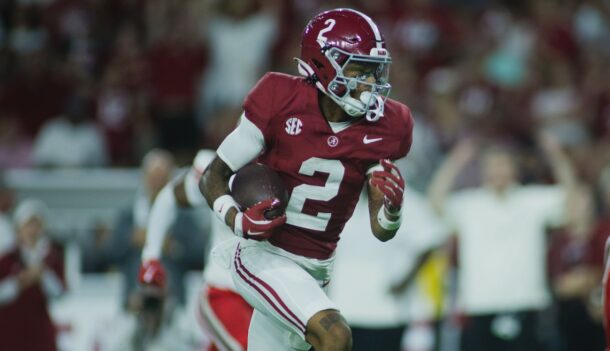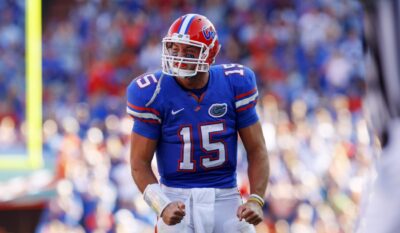
Every SEC team’s best decade, including the two that just enjoyed theirs
Throughout the 2016 season, we ran nearly 20 pieces on Nick Saban’s “Decade of Dominance” as he coached his 10th year in Tuscaloosa, but what about every other school’s best 10-year stretch?
For some teams, it only takes a short trip down memory lane, but others require a time machine.
We determined these based on total wins, but it’s worth noting that there were many overlapping years that may have had the same amount. We mention all those years below but only picked one while explaining our rationale.
Alabama (2007-16)
Saban’s arrival signaled success that has rarely been matched during this kind of timeframe. Since his second season, the Crimson Tide have won at least 10 games every year with four national titles and five SEC titles, including each of the last three.
Over this time, Alabama has officially won 114 games. While some will point to more games being played these days, the fact remains that the Tide have consistently won those extra contests. As you’ll see, many SEC teams enjoyed their best stretches before the turn of the century anyways.
An honorable mention here is Alabama’s 1971-80 years under Paul “Bear” Bryant, who led the team to 107 wins and a superior winning percentage (.892 to .857) with three national titles (two from AP, one from UPI).
Arkansas (1977-86)
Arkansas’ only national championship may have come in 1964 by way of the Football Writers Association of America (FWAA), but the Razorbacks enjoyed their best 10-year run — 86 wins — as soon as Lou Holtz came to town.
The Hogs, competing in the Southwest Conference, won at least nine games in four of his seven seasons, including an 11-win campaign capped by an Orange Bowl victory over Oklahoma in his first season.
In 1985 and 1986, Ken Hatfield would tack on a couple more 9-win seasons to finish it up.
Auburn (2002-11)
The Tigers won 94 games here, although the undefeated 13-0 team in 2004 didn’t reap the rewards it sought. Of course, the team’s next undefeated team in 2010 led by Cam Newton wouldn’t be denied.
Those two years would produce two of three SEC championships won by Auburn since divisions were created in 1992, the other coming in 2013.
Tommy Tuberville was at the helm for seven of those 10 seasons, and the Tigers went an impressive 8-1 in bowl games.
Florida (1991-00)
Ah, if only the Gators could rewind time and relive the Fun ‘N Gun years right about now with the struggles the team has had throwing the ball.
In just his second season in Gainesville, Steve Spurrier began his unprecedented dominance of the SEC. He claimed six conference titles during this time, including four straight from 1993-96, a feat that even Saban hasn’t equalled (he’ll get his chance next season). UF also earned its first national title in 1996.
Florida won 103 games here, which was also done from 1992-01, but the school picked up one fewer SEC championship over that span so the edge goes to 1991-00.
Georgia (1999-08)
The best of the Bulldogs came by way of 98 wins, mostly thanks to Mark Richt.
After a pair of 8-4 seasons under Jim Donnan, Richt led the school to 10 wins in six of the next eight years, including SEC championships in 2002 and 2005, the only ones for UGA since 1982. The Dawgs also went 8-2 in bowls.
The team also recorded 98 wins during 2000-09 and 2002-11, but Georgia had a slightly better winning percentage from 1999-08 (.766), never losing more than four games in a season.
Kentucky (1946-55)
The Wildcats’ winningest stretch came at the same time as Paul “Bear” Bryant, who coached the first eight of these 10 seasons in leading the school to 73 victories.
The Bear-led Wildcats won their first SEC championship in 1950 behind a school-record 11 wins, and Kentucky finished ranked in each of Bryant’s last five seasons.
From 1949-51, the ‘Cats appeared in the Orange Bowl, Sugar Bowl and Cotton Bowl, winning the last two. Blanton Collier coached the final two seasons of this frame and won 13 games.
LSU (2003-12)
The Tigers won a whopping 107 games during these years. It all started in Saban’s fourth year with the school as he guided it to a national championship win over Oklahoma and Heisman winner Jason White.
In 2005, Les Miles took over and was even quicker to guide LSU to a national title, doing so in his third year in Baton Rouge. He made another appearance in the big game in 2011 but lost to his predecessor.
The Tigers enjoyed 11 wins in six of these 10 years, posting an .811 winning percentage.
Mississippi State (2007-16)
Like Alabama, Mississippi State also just enjoyed its best stretch in program history (73 wins) even though it didn’t carry the same kind of hardware.
Dan Mullen has been on the sidelines for eight of these seasons, taking the team bowling in each of the last seven. MSU posted back-to-back 9-win seasons in 2014-15, ascending to AP No. 1 in 2014, both firsts for the program.
Mississippi State has still had a tough time breaking through in the league, only finishing higher than fourth in the SEC West in one of these seasons (second in 2014).
Missouri (2005-14)
The Tigers are coming off a 91-win period not long ago. That started in 2005 as Mizzou was competing in the Big 12.
The school ended up with 10-win seasons in half of these years, the last two coming as a member of the SEC, representing the East but losing in two trips to Atlanta.
Missouri was ranked in the AP top 5 in four of these years, grabbing the No. 1 spot after a 36-28 win over second-ranked Kansas in 2007.
Ole Miss (1954-63)
The FWAA tabbed the Rebels as national champions in 1960, which was a part of their winningest 10-year span (90 wins).
Johnny Vaught guided Ole Miss to 9 wins in all but two of these years as the school won five SEC championships (1954-55, 1960, 1962-63). All of this, and Archie Manning was still a few years from stepping on the scene.
The Rebels also won 90 games from 1953-62, but the team’s 1963 season bestowed an SEC title to give an edge to the 1954-63 period.
South Carolina (2005-14)
It’s been a bit of a trend in this piece, but a legendary coach has marked the beginning of these glory years — or at least arrives in the early portion of them.
Spurrier actually occupies every one of these years, all of which pertain to his 10 full years in Columbia, as the team racked up 84 wins. Before his arrival, South Carolina had only had one 10-win season (1984), yet the school posted three straight 11-win seasons from 2011-13.
The Gamecocks held an AP top 10 ranking at some point in six of those 10 years.
Tennessee (1989-98)
The Vols enjoyed their best run at the tail end of the Johnny Majors era and the start of Phil Fulmer’s.
Tennessee won 101 games over this stretch as Fulmer led the team to 10-win seasons in each of the last four, including a national championship in 1998, the first year of the BCS era.
The Vols also won 101 games from 1995-04, but the period from 1989-98 yielded two additional SEC championships (a share of one in 1989 and an outright crown in 1990). Plus, the team had a better winning percentage (.836 compared to .802).
Texas A&M (1985-94)
Jackie Sherrill’s last four years and R.C. Slocum’s first six years make up the Aggies’ winningest time, which produced 95 wins competing in the Southwest Conference.
Texas A&M won the league championship in six of the 10 years, consisting of two separate three-year reigns from 1985-87 and 1991-93.
Slocum led the Aggies to four straight 10-win seasons to close this period. The school has only done that back-to-back one other time, and that was in 1975-76 under Emory Bellard.
Vanderbilt (1903-12)
For Kentucky and Ole Miss, we had to go pretty far back, but we had to take a quantum leap for Vanderbilt.
The Commodores had 73 wins near the beginning of the 20th century. The school was still 21 years away from being a charter member of the SEC in 1933 at the end of this run.
Vandy wrapped it up with three straight noteworthy seasons, going 8-0-1, 8-1 and 8-1-1 under Dan McGugin.
Born and raised in Gainesville, Talal joined SDS in 2015 after spending 2 years in Bristol as an ESPN researcher. Previously, Talal worked at The Gainesville Sun.







